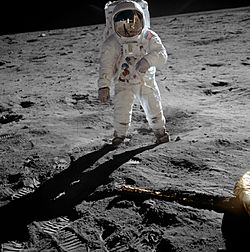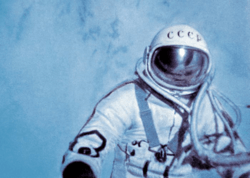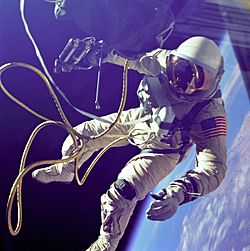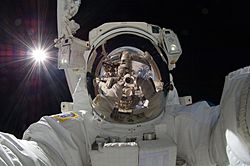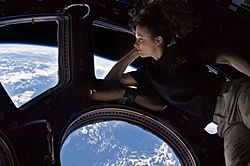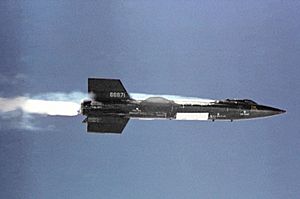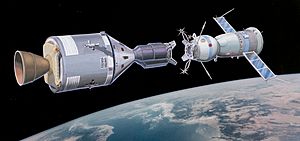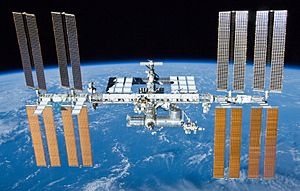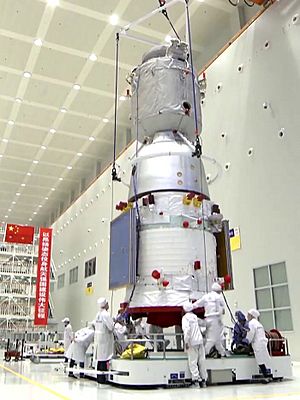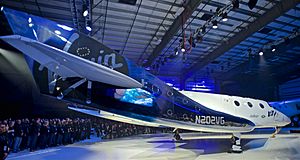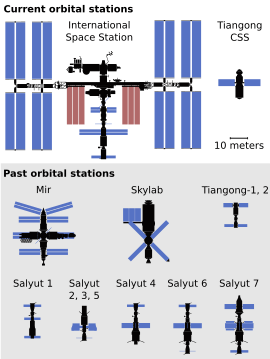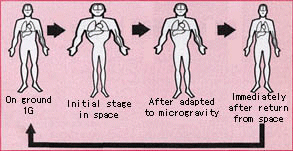Human spaceflight facts for kids
Human spaceflight is when people travel into space aboard a spacecraft. Sometimes, the people on board control the spacecraft themselves. Other times, it's controlled from Earth or flies on its own. People who are trained for space travel are called astronauts (in America and other countries), cosmonauts (in Russia), or taikonauts (in China). People who are not professional astronauts but travel to space are called spaceflight participants.
The first person in space was Yuri Gagarin, a Soviet cosmonaut. He launched on April 12, 1961, during the Space Race. Soon after, on May 5, 1961, Alan Shepard became the first American in space.
Humans have visited the Moon nine times between 1968 and 1972 as part of the United States' Apollo program. Since November 2, 2000, people have lived continuously in space on the International Space Station (ISS). China sent its first taikonaut, Yang Liwei, into space on October 15, 2003. This was China's first human spaceflight. As of now, humans have not traveled beyond low Earth orbit since the Apollo 17 mission to the Moon in December 1972.
Today, the United States, Russia, and China are the only countries with their own human spaceflight programs. Some private companies are also developing space programs for things like space tourism or research. The first private human spaceflight was a short trip on SpaceShipOne on June 21, 2004. The first commercial launch to orbit with a crew was by SpaceX in May 2020. They took NASA astronauts to the ISS.
Contents
History of Space Travel
The Cold War Space Race
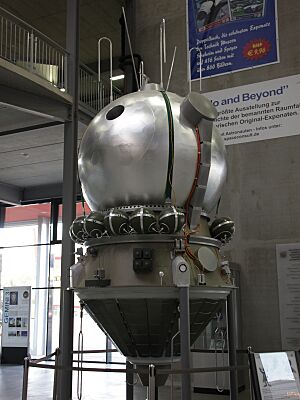
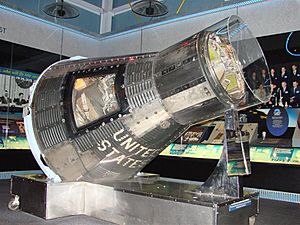
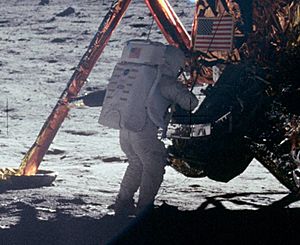
Human spaceflight began during the Cold War between the United States and the Soviet Union. Both nations built powerful rockets for weapons. These rockets were then used to launch the first artificial satellites into space.
After the Soviet Union launched the first satellites in 1957 and 1958, the U.S. started Project Mercury. Their goal was to send people into orbit. The Soviet Union secretly worked on their Vostok program for the same goal. They launched the first human, Yuri Gagarin, into space on April 12, 1961. Gagarin orbited Earth once in his Vostok 1 spacecraft.
On May 5, 1961, the U.S. launched its first astronaut, Alan Shepard. He made a short suborbital flight in Freedom 7. Unlike Gagarin, Shepard controlled his spacecraft himself. On February 20, 1962, John Glenn became the first American to orbit Earth. The Soviet Union sent five more cosmonauts into space, including the first woman, Valentina Tereshkova, on June 16, 1963. The U.S. also had two flights of the North American X-15 rocket plane that reached the edge of space.
In 1961, U.S. President John F. Kennedy set a big goal: to land a person on the Moon and bring them back safely by the end of the 1960s. The U.S. started the Apollo program to send three-person capsules to the Moon. In 1962, they also began Project Gemini. This program flew 10 missions with two-person crews in 1965 and 1966. Gemini helped the U.S. gain experience in orbital spaceflight for the Moon missions.
The Soviet Union kept their Moon plans secret. They changed their Vostok capsule to carry two or three people, calling it Voskhod. They launched two flights in 1964 and 1965. On March 8, 1965, Alexei Leonov performed the first spacewalk. However, the Voskhod program ended because it couldn't maneuver in orbit like Gemini. The U.S. Gemini flights performed many spacewalks. They also showed that humans could stay in space for two weeks. They achieved the first space rendezvous (meeting in space) and docking (connecting two spacecraft).
The U.S. built the powerful Saturn V rocket for the Apollo missions. In December 1968, Frank Borman, James Lovell, and William Anders orbited the Moon ten times in Apollo 8. In 1969, Apollo 11 achieved Kennedy's goal. Neil Armstrong and Buzz Aldrin landed on the Moon on July 21. They returned safely on July 24 with Michael Collins. By 1972, six Apollo missions had landed 12 men on the Moon. Half of them drove electric vehicles on the surface. The crew of Apollo 13 survived a spacecraft problem and returned safely to Earth without landing on the Moon.
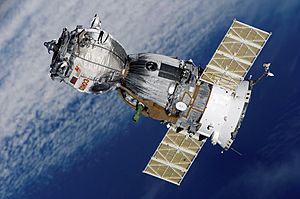

During this time, the Soviet Union secretly worked on their own Moon programs. They developed the three-person Soyuz spacecraft. But they failed to build the N1 rocket needed for a human Moon landing. They stopped their Moon programs in 1974. After losing the Moon race, they focused on building space stations. They used Soyuz to carry cosmonauts to and from these stations. They started with Salyut stations from 1971 to 1986.
After the Apollo Program
After Apollo, the U.S. planned a new Space Transportation System. This included a reusable Space Shuttle and a permanent space station. However, these plans were scaled back. The Space Shuttle was redesigned to use reusable solid rocket boosters and an external fuel tank. The Shuttle would land without power.
In 1973, the U.S. launched the Skylab space station. Three crews lived there for 171 days using Apollo spacecraft. In 1975, the U.S. and Soviet Union worked together on the Apollo–Soyuz program. An Apollo spacecraft connected with Soyuz 19. American and Soviet crews shook hands in space. This was a symbol of easing Cold War tensions.
The two nations continued to compete. The U.S. developed the Space Shuttle and planned the Freedom space station. The Soviet Union launched military stations called Almaz, disguised as Salyuts. They then developed Mir, the first modular space station. Mir was built from 1986 to 1996. It orbited at about 354 kilometers (220 miles) high. Mir was occupied for over 12 years before being safely brought back to Earth in 2001.
The Space Shuttle began flying in 1981. A fleet of four Shuttles was built: Columbia, Challenger, Discovery, and Atlantis. A fifth, Endeavour, replaced Challenger. Challenger was destroyed in an accident during launch on January 28, 1986, killing all seven astronauts. From 1983 to 1998, Shuttle flights carried parts for a European space station called Spacelab.
The Soviet Union also built a reusable Space Shuttle orbiter called Buran. It was designed to launch on the Energia rocket. Buran could fly and land on its own without a crew. It had one uncrewed test flight in November 1988. The program was canceled due to lack of money and the end of the Soviet Union in 1991.
US and Russian Cooperation
The end of the Soviet Union in 1991 led to cooperation between the U.S. and Russia. Russia's space agency, Roscosmos State Corporation, took over the Soyuz and Mir programs. The Shuttle-Mir Program involved American Space Shuttles visiting the Mir space station. Russian cosmonauts flew on the Shuttle, and American astronauts lived on Mir for long periods.
In 1993, U.S. President Bill Clinton worked with Russia to change the planned Space Station Freedom into the International Space Station (ISS). Construction of the ISS began in 1998. It orbits at about 409 kilometers (254 miles) high. Many Space Shuttle flights helped build, supply, and crew the ISS. Russia continues to work with the U.S. on the ISS.
China's Space Program
China became the third nation to send humans into space, after the Soviet Union and the U.S. In 1967, China started its own secret crewed space program, Project 714. It aimed to send two people into space by 1973. However, this program was canceled in 1972 for money reasons.
In 1992, China started a new program called "Project 921" or China Manned Space Program (CMS). This program aimed to achieve independent human spaceflight. China developed the Shenzhou spacecraft and the Long March 2F rocket. They also built a new launch site and flight control center. The first uncrewed Shenzhou 1 spacecraft launched on November 20, 1999. This was a big step for China's human spaceflight. After three more uncrewed missions, Shenzhou 5 launched on October 15, 2003. It carried Yang Liwei into orbit for 21 hours. China became the third nation to launch a human into orbit on its own.
The next goal for CMS was to master spacewalks and docking. On September 25, 2008, during the Shenzhou 7 flight, Zhai Zhigang and Liu Boming completed China's first spacewalk. In 2011, China launched the Tiangong 1 target spacecraft and Shenzhou 8. They completed China's first automatic docking. Later, Tiangong 1 docked manually with Shenzhou 9, which carried China's first female astronaut, Liu Yang.
In September 2016, Tiangong 2 was launched. It was a more advanced space laboratory. A month later, Shenzhou 11 docked with Tiangong 2. Two astronauts stayed there for about 30 days, proving that astronauts could live in space for medium periods. In April 2017, China's first cargo spacecraft, Tianzhou 1, docked with Tiangong 2. It completed tests for refueling in orbit. This marked the successful end of the second phase of CMS.
The third phase of CMS began in 2020. The goal is to build China's own space station, Tiangong. The first part of Tiangong, the Tianhe core module, launched on April 29, 2021. It has been visited by many cargo and crewed spacecraft. This shows China can support astronauts living in space for a long time. The construction of Tiangong was completed by the end of 2022. It is expected to be used for at least 10 years.
Abandoned Programs by Other Nations
Some other countries also tried to develop human spaceflight programs but later stopped them.
- The European Space Agency started developing the Hermes shuttle in 1987. It was meant to dock with a European space station. Both projects were canceled in 1992 because they were too expensive and couldn't meet goals.
- Japan (NASDA) began developing the HOPE-X experimental shuttle in the 1980s. After some failures, the project was canceled in 2003. Japan instead joined the International Space Station program.
- From 1993 to 1997, Japanese companies worked on a proposed reusable launch system called Kankoh-maru. This system was later suggested for space tourism in 2005.
- Iraq had plans to develop its own crewed space facilities by the end of the century, but these plans ended after the Gulf War in 1991.
U.S. "Shuttle Gap"
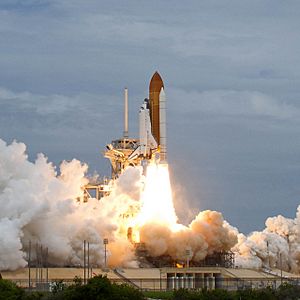
The U.S. Space Shuttle program ended in 2011. There was a period, called the "U.S. human spaceflight gap," until December 13, 2018, when SpaceShipTwo Flight VP-03 launched. During this gap, the U.S. relied on Russia to send its astronauts to the ISS.
NASA is now developing the Orion spacecraft and the Space Launch System rocket for missions beyond low Earth orbit, including to the Moon and Mars. For travel to low Earth orbit, NASA uses private companies like SpaceX Dragon 2 and Boeing Starliner.
Commercial Private Spaceflight
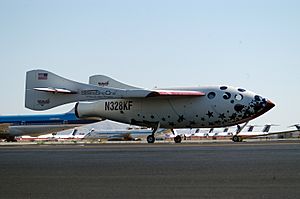
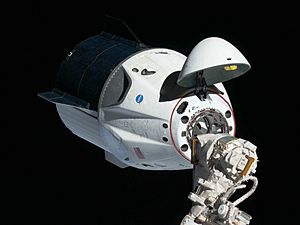
Since the early 2000s, many private companies have started spaceflight ventures. As of November 2024, SpaceX and Boeing have launched humans to orbit. Blue Origin has launched 8 crewed flights, with six crossing the Kármán line (the commonly used boundary of space at 100 km altitude). Virgin Galactic has also launched crews on short suborbital trips. These companies plan to fly commercial passengers for space tourism.
- SpaceX developed Crew Dragon, which flies on the Falcon 9 rocket. It first launched astronauts to the ISS in May 2020. This capsule is also used for tourist flights, like Inspiration4 in September 2021.
- Boeing developed the Starliner capsule, launched on an Atlas V rocket. It had an uncrewed flight in December 2019 and another in May 2022. A crewed flight to fully test Starliner launched in June 2024.
- Virgin Galactic is developing SpaceshipTwo for suborbital space tourism. It reached space in December 2018.
- Blue Origin is testing its New Shepard vehicle. As of May 2025, it has made thirty-one launches, including eleven with crews. The first crewed flight, carrying founder Jeff Bezos, launched on July 20, 2021.
Passenger Travel in Space
Many ideas for "spaceliners" have been suggested over the years. These would be like airliners, carrying many passengers to space or for fast travel on Earth. So far, none of these large concepts have been built. However, smaller vehicles carrying fewer than 10 people are being tested.
One large concept is the SpaceX Starship. SpaceX suggests it could carry over 100 people suborbitally between two points on Earth in under an hour.
Smaller spaceplanes or capsules are also being developed. Virgin Galactic has the SpaceShipTwo spaceplane, and Blue Origin has the New Shepard capsule. Both aim to take about six passengers into space for a short time of zero gravity before returning.
Human Representation in Space
Space exploration has always raised questions about who gets to go. International space law says space is the "province of all mankind." However, some criticize that not all countries, women, or people of color have been equally included. Groups like the Justspace Alliance work to make spaceflight more inclusive.
Women in Space
The first woman in space was Valentina Tereshkova in 1963. It took until the 1980s for another woman to fly. Back then, astronauts had to be military test pilots, a job women couldn't have. After rules changed, Svetlana Savitskaya became the second woman in space, also from the Soviet Union. Sally Ride was the first American woman in space. Since then, women from eleven other countries have become astronauts. The first spacewalk with only women happened in 2018, performed by Christina Koch and Jessica Meir. A mission to the Moon with a woman aboard is planned for 2024.
Even with these steps, women are still a small part of astronauts and cosmonauts. More than 600 people have flown in space, but only 75 have been women. Some reasons for this include:
- Agencies sometimes limit women's time in space due to concerns about cancer risk.
- There aren't enough space suits made in sizes that fit female astronauts well.
Space Milestones
By Country
This table shows the first citizen and first spacecraft from each country to achieve major space milestones.
| Country | Citizen to space (Spaceflight) | Crewed spaceflight launch | Citizen to land on moon |
|---|---|---|---|
| Yuri Gagarin, ( |
Vostok 1, 1961 | ||
| Alan Shepard, ( |
Freedom 7, 1961 | Neil Armstrong (Apollo 11, 1969) | |
| Vladimír Remek ( |
|||
| Mirosław Hermaszewski ( |
|||
| Sigmund Jähn ( |
|||
| Georgi Ivanov ( |
|||
| Bertalan Farkas ( |
|||
| Phạm Tuân ( |
|||
| Arnaldo Tamayo Méndez ( |
|||
| Jügderdemidiin Gürragchaa ( |
|||
| Dumitru Prunariu ( |
|||
| Jean-Loup Chrétien ( |
|||
| Ulf Merbold ( |
|||
| Rakesh Sharma ( |
|||
| Marc Garneau ( |
|||
| Sultan Al-Saud ( |
|||
| Wubbo Ockels ( |
|||
| Rodolfo Neri Vela ( |
|||
| Muhammed Faris ( |
|||
| Abdul Mohmand ( |
|||
| Toyohiro Akiyama ( |
|||
| Helen Sharman ( |
|||
| Franz Viehböck ( |
|||
| Klaus-Dietrich Flade ( |
|||
| Aleksandr Kaleri ( |
Soyuz TM-14, 1992 | ||
| Franco Malerba ( |
|||
| Claude Nicollier ( |
|||
| Talgat Musabayev ( |
|||
| Leonid Kadeniuk ( |
|||
| Pedro Duque ( |
|||
| Ivan Bella ( |
|||
| Mark Shuttleworth ( |
|||
| Ilan Ramon ( |
|||
| Yang Liwei ( |
Shenzhou 5, 2003 | ||
| Marcos Pontes ( |
|||
| Christer Fuglesang ( |
|||
| Sheikh Muszaphar Shukor ( |
|||
| Yi So-Yeon ( |
|||
| Andreas Mogensen ( |
|||
| Aidyn Aimbetov ( |
|||
| Hazza Al Mansouri ( |
|||
| Chris Boshuizen ( |
|||
| Mário Ferreira ( |
|||
| Sara Sabry ( |
|||
| Alper Gezeravcı ( |
|||
| Marina Vasilevskaya ( |
By Achievement
- April 12, 1961: Yuri Gagarin was the first human in space and the first to orbit Earth.
- March 18, 1965: Alexei Leonov was the first to walk in space (spacewalk).
- December 15, 1965: Walter M. Schirra and Tom Stafford were the first to perform a space rendezvous. They flew their Gemini 6A spacecraft very close to Gemini 7 for over 5 hours.
- March 16, 1966: Neil Armstrong and David Scott were the first to rendezvous and dock. They connected their Gemini 8 spacecraft with an uncrewed vehicle.
- December 21–27, 1968: Frank Borman, Jim Lovell, and William Anders were the first to travel beyond low Earth orbit. They were also the first to orbit the Moon on the Apollo 8 mission.
- May 26, 1969: Apollo 10 reached the fastest speed ever traveled by humans: 39,897 km/h (24,791 mph).
- July 20, 1969: Neil Armstrong and Buzz Aldrin were the first to land on the Moon during Apollo 11.
- April 14, 1970: The crew of Apollo 13 set the record for the highest distance from Earth for a crewed spacecraft: 400,171 kilometers (248,655 miles).
- Longest time in space: Valeri Polyakov spent the longest time on a single spaceflight: 437 days (from January 8, 1994, to March 22, 1995). Oleg Kononenko has spent the most total time in space across multiple missions: over 1,110 days.
- Longest-duration crewed space station: The International Space Station has had people living on it continuously since November 2, 2000. This is the longest continuous human presence in space.
By Nationality or Sex
- April 12, 1961: Yuri Gagarin became the first Soviet and first human in space.
- May 5, 1961: Alan Shepard became the first American in space.
- February 20, 1962: John Glenn became the first American to orbit Earth.
- June 16, 1963: Valentina Tereshkova became the first woman in space and the first woman to orbit Earth.
- March 2, 1978: Vladimír Remek from Czechoslovakia became the first non-American and non-Soviet person in space.
- April 2, 1984: Rakesh Sharma became the first Indian in space.
- July 25, 1984: Svetlana Savitskaya became the first woman to walk in space.
- October 15, 2003: Yang Liwei became the first Chinese person in space.
- October 18, 2019: Christina Koch and Jessica Meir performed the first spacewalk with only women.
Sally Ride was the first American woman in space in 1983. Eileen Collins was the first female Space Shuttle pilot and the first woman to command a U.S. spacecraft in 1999.
For many years, only astronauts from the Soviet Union (later Russia) and the United States flew in space. This changed in 1978 with Vladimir Remek's flight. As of 2010, people from 38 nations have flown in space.
Space Programs
Human spaceflight programs have been run by the Soviet Union/Russian Federation, the United States, China, and American private companies.
Currently have human spaceflight programs. Confirmed and dated plans for human spaceflight programs. Confirmed plans for human spaceflight programs. Plans for human spaceflight on the simplest form (suborbital spaceflight, etc.). Plans for human spaceflight on the extreme form (space stations, etc.). Once had official plans for human spaceflight programs, but have since been abandoned.
Current Programs
The following spacecraft and launch sites are currently used for human spaceflights:
- Soyuz program (Russia): Launched from Baikonur Cosmodrome. The first crewed flight was in 1967. As of March 2025, there have been 153 crewed flights.
- China Manned Space Program/Shenzhou spacecraft (China): Launched from Jiuquan Satellite Launch Center. The first crewed flight was in 2003. As of March 2025, there have been 14 crewed orbital flights.
- SpaceX Crew Dragon (U.S.): Launched from Kennedy Space Center Launch Complex 39A or Cape Canaveral Space Launch Complex 40. The first crewed flight was in 2020. As of March 2025, there have been 16 crewed orbital flights.
- New Shepard (U.S.): Launched from Corn Ranch spaceport. The first crewed flight was in 2021. As of March 2025, there have been ten crewed suborbital flights.
- Boeing Starliner (U.S.): Launched from Cape Canaveral Space Launch Complex 41. The first crewed launch was in 2024. As of March 2025, there has been 1 crewed orbital launch.
The following space stations are currently in Earth orbit for people to live on:
- International Space Station (U.S., Russia, Europe, Japan, Canada): Built in orbit, it flies at about 409 kilometers (254 miles) high. Crews are taken there by Soyuz or Crew Dragon spacecraft.
- Tiangong Space Station (China): Built in orbit. Crews are taken there by Shenzhou spacecraft.
Most of the time, the only humans in space are those on the ISS (usually 7 people) and on Tiangong (usually 3 people).
NASA and ESA use the term "human spaceflight." They used to say "manned space missions," but now they use gender-neutral language.
Planned Future Programs
- India: The Indian Human Spaceflight Program plans to send humans into space on its Gaganyaan vehicle. This is now expected in 2024. The goal is to send 2 or 3 crew members to low Earth orbit for 3 to 7 days. India also plans a space station by 2030 and a crewed lunar mission.
- NASA: NASA is developing a plan to land humans on Mars by the 2030s. The first step was Artemis I in 2022, which sent an uncrewed Orion spacecraft around the Moon.
- SpaceX: SpaceX is developing Starship, a fully reusable rocket system. It aims to land on Mars. A special version of Starship is being developed for the Artemis program.
- Other countries like Japan (JAXA), Iran (ISA), and North Korea (NADA) have also announced plans for human spaceflight programs.
National Spacefaring Attempts
This section lists nations that have tried to create their own human spaceflight programs. It does not include countries whose citizens have flown in space using another country's or private company's spacecraft.
| Nation/Organization | Space agency | Term(s) for space traveler | First launched astronaut | Date | Spacecraft | Launcher | Type |
|---|---|---|---|---|---|---|---|
(1922–1991) |
Soviet space program (OKB-1 Design Bureau) |
космонавт (same word in:) kosmonavt cosmonaut Ғарышкер |
Yuri Gagarin | 12 April 1961 | Vostok spacecraft | Vostok | Orbital |
| National Aeronautics and Space Administration (NASA) | astronaut spaceflight participant |
Alan Shepard (suborbital) | 5 May 1961 | Mercury spacecraft | Redstone | Suborbital | |
| National Aeronautics and Space Administration (NASA) | astronaut spaceflight participant |
John Glenn (orbital) | 20 February 1962 | Mercury spacecraft | Atlas LV-3B | Orbital | |
| Space program of the People's Republic of China | 宇航员 (Chinese) yǔhángyuán 航天员 (Chinese) hángtiānyuán |
— | 1973 (abandoned) | Shuguang | Long March 2A | Orbital | |
| Space program of the People's Republic of China | 宇航员 (Chinese) yǔhángyuán 航天员 (Chinese) hángtiānyuán |
— | 1981 (abandoned) | Piloted FSW | Long March 2 | Orbital | |
| CNES / European Space Agency (ESA) | spationaute astronaut |
— | 1992 (abandoned) | Hermes | Ariane V | Orbital | |
| Roscosmos | космонавт kosmonavt cosmonaut |
Alexander Viktorenko, Alexander Kaleri | 17 March 1992 | Soyuz TM-14 to MIR | Soyuz-U2 | Orbital | |
(1968–2003) |
— | رجل فضاء (Arabic) rajul faḍāʼ رائد فضاء (Arabic) rāʼid faḍāʼ ملاح فضائي (Arabic) mallāḥ faḍāʼiy |
— | 2001 (abandoned) | — | Tammouz 2 or 3 | N/A |
| National Space Development Agency of Japan (NASDA) | 宇宙飛行士 (Japanese) uchūhikōshi or アストロノート asutoronoto |
— | 2003 (abandoned) | HOPE | H-II | Orbital | |
| China Manned Space Agency (CMSA) | 宇航员 (Chinese) yǔhángyuán 航天员 (Chinese) hángtiānyuán taikonaut (太空人; tàikōng rén) |
Yang Liwei | 15 October 2003 | Shenzhou spacecraft | Long March 2F | Orbital | |
| Japanese Rocket Society [ja], Kawasaki Heavy Industries and Mitsubishi Heavy Industries | 宇宙飛行士 (Japanese) uchūhikōshi or アストロノート asutoronoto |
— | 2000s (abandoned) | Kankoh-maru | Kankoh-maru | Orbital | |
| Japan Aerospace Exploration Agency (JAXA) | 宇宙飛行士 (Japanese) uchūhikōshi or アストロノート asutoronoto |
— | 2003 (abandoned) | Fuji | H-II | Orbital | |
| Indian Space Research Organisation (ISRO) | Vyomanaut |
— | 2024 | Gaganyaan | LVM 3 | Orbital | |
| European Space Agency (ESA) | astronaut | — | 2020 (concept approved in 2009; but full development not begun) | CSTS, ARV phase-2 | Ariane V | Orbital | |
| Japan Aerospace Exploration Agency (JAXA) | 宇宙飛行士 (Japanese) uchūhikōshi or アストロノート asutoronoto |
— | TBD | HTV-based spacecraft | H3 | Orbital | |
| Iranian Space Agency (ISA) | — | — | 2019 (on hold) | ISA spacecraft | TBD | Orbital | |
| National Aerospace Development Administration (NADA) | — | — | 2020s | NADA spacecraft | Unha 9 | Orbital | |
| Copenhagen Suborbitals | astronaut | — | 2020s | Tycho Brahe | SPICA | Suborbital |

Safety in Space
Space travel has two main dangers: the harsh space environment and possible equipment problems. Space agencies work hard to solve these issues for long missions, like trips to Mars.
Environmental Dangers
Life Support Systems
Spacecraft have life support systems to provide breathable air and drinkable water.
Health Issues
Astronauts in space cannot quickly return to Earth for medical help. They must rely on limited supplies and advice from Earth.
Long spaceflights can cause problems like blindness and bone loss. In 2012, a study suggested spaceflight might harm astronauts' brains and speed up Alzheimer's disease. In 2015, NASA reported on health risks for a human mission to Mars.
In 2017, MRI scans showed changes in astronauts' brains after space trips. Longer trips caused bigger changes. In 2018, scientists found bacteria on the ISS. They said microorganisms on the ISS need to be watched to keep astronauts healthy. In March 2019, NASA reported that hidden viruses in humans might become active during space missions. This could add more risk to future deep-space missions.
In September 2021, an alarm went off during the Inspiration4 flight. It was linked to a toilet problem.
Microgravity Effects
Living in microgravity (weightlessness) for long periods has several effects:
- Astronauts lose bone density and muscle strength.
- Their balance and ability to do aerobic exercise decrease.
- These changes can make it harder for astronauts to perform tasks or increase their risk of injury.
- Astronauts can lose up to 20% of their muscle mass on short flights. This loss of strength could be dangerous in an emergency landing.
- After long flights, astronauts are very weak. They are not allowed to drive for three weeks.
- Weightlessness can cause astronauts to feel disoriented and get motion sickness. When they return to Earth, they need to readjust. They may have trouble standing, walking, or focusing their eyes. These problems get worse with longer time in space.
- Long space flights can also cause severe eyesight problems for male astronauts. This is a big concern for future missions to Mars.
Radiation Dangers

Outside Earth's protective magnetosphere, astronauts face high-energy radiation from solar particle events (SPEs) and cosmic rays. A strong solar storm could cause acute radiation sickness or even be deadly in a poorly shielded spacecraft. A solar storm in August 1972 could have been lethal for astronauts on the Moon or doing spacewalks.
There are also concerns that long spaceflights might weaken the body's immune system. This could activate hidden viruses. Radiation can harm the cells that make blood and immune cells. In a small spacecraft, a weakened immune system could lead to infections spreading quickly.
Isolation and Mental Health
During long missions, astronauts are isolated in small spaces. This can lead to depression, anxiety, and other mental health problems. These issues can affect crew safety and mission success. NASA spends a lot of money on psychological support for astronauts. There is currently no way to fully prevent these mental problems from long stays in space.
Sometimes, astronauts' mental health problems have led to missions being cut short. In 1976, a Russian crew returned to Earth after reporting a strong smell. An investigation found no leak, and NASA concluded the cosmonauts likely hallucinated the smell.
Changes in sensory input during long space travel can also affect astronauts' mental health.
Sensory System Changes
In space, astronauts live in an extreme environment with little change. This can weaken their seven senses:
- Hearing: There are no outside noises in space. Inside, mechanical noises and familiar voices become less stimulating.
- Sight: In weightlessness, body fluids shift to the face, causing swelling and affecting vision. The view outside is constant, reducing visual stimulation. Cosmic rays can cause astronauts to see flashes, even with their eyes closed.
- Smell: The space station has a constant smell like gunpowder. Zero gravity can dull the sense of smell.
- Taste: Taste is linked to smell, so it also becomes dull. Astronaut food is often bland and has little variety.
- Touch: There are almost no new physical sensations or human contact during the journey.
- Vestibular system (motion and balance): The lack of gravity damages this system, changing how astronauts move.
- Proprioception system (body awareness): Weightlessness means fewer forces on muscles, reducing stimulation to this system.
Equipment Dangers
Space travel requires very high speeds and powerful fuels. It also involves dealing with a lot of heat when returning through Earth's atmosphere.
Launch Safety
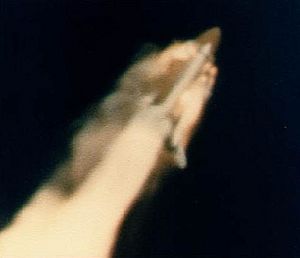
Rockets can catch fire or explode. So, spacecraft often have a launch escape system. This is usually a small rocket that pulls the capsule away from the main rocket quickly. This system was used on Mercury, Apollo, and Soyuz spacecraft. Some early spacecraft used ejection seats for astronauts to escape.
Launch escape systems are not always practical for spacecraft with many crew members, especially spaceplanes. The Voskhod capsule, which carried 2 or 3 people, did not have an escape system. The Space Shuttle had ejection seats for its pilot and copilot in early flights, but these were removed later.
There have been only two in-flight launch aborts of crewed flights where the crew survived:
- The first was on Soyuz 18a on April 5, 1975. The rocket went off course, but the crew separated their spacecraft and landed safely.
- The second was on October 11, 2018, with Soyuz MS-10. Both crew members survived.
The only time a launch escape system was used on the launchpad before liftoff was for Soyuz T-10a on September 26, 1983. A fire started in the rocket, but both cosmonauts escaped safely.
The only crew deaths during launch happened on January 28, 1986. The Space Shuttle Challenger broke apart 73 seconds after liftoff. A seal on a solid rocket booster failed, causing the fuel tank to explode. All seven crew members died.
Spacewalk Safety
Tasks outside a spacecraft require a space suit. Despite the risks, there have been no deaths during spacewalks. Spacewalking astronauts are usually attached to the spacecraft with tethers.
Reentry and Landing Safety
The pilot of Soyuz 1, Vladimir Komarov, died when his capsule's parachutes failed during an emergency landing on April 24, 1967. The capsule crashed.
On February 1, 2003, all seven crew members aboard the Space Shuttle Columbia died during reentry. A heat shield on the wing was damaged during launch by a piece of foam. Hot gases entered the wing, destroying the structure and causing the orbiter to break apart.
Artificial Atmosphere Risks
Spacecraft use an artificial atmosphere, either a mix of oxygen and another gas (like nitrogen) or pure oxygen at lower pressure. The International Space Station and Soyuz use a nitrogen-oxygen mix. Space suits for spacewalks use pure oxygen.
Using a gas mixture can cause decompression sickness (the "bends") when moving to a pure oxygen space suit. There have been injuries and deaths from too much nitrogen and not enough oxygen.
- In 1960, a test pilot was seriously injured when nitrogen-rich air leaked into his space suit. This led NASA to use pure oxygen for Mercury, Gemini, and Apollo spacecraft.
- In 1981, three workers died from a nitrogen-rich atmosphere in the Space Shuttle's engine area.
- In 1995, two workers died from a nitrogen leak at a rocket launch pad.
A pure oxygen atmosphere has a fire risk. The original Apollo spacecraft used pure oxygen at high pressure before launch. A fire started in the Apollo 1 cabin during a ground test on January 27, 1967. The fire spread quickly due to the high pressure and flammable materials. The crew could not open the hatch in time. All three astronauts—Gus Grissom, Ed White, and Roger Chaffee—died. This led NASA to use a nitrogen-oxygen atmosphere before launch and pure oxygen only in space.
Reliability of Equipment
The Gemini 8 mission in March 1966 was cut short when a thruster got stuck on, causing the spacecraft to spin dangerously. Neil Armstrong had to use a different control system to stop the spin. The spacecraft made an emergency landing, and the astronauts were safe. The problem was likely an electrical short.
The Apollo 13 mission in April 1970 was aborted after an oxygen tank failed on the way to the Moon. The tank burst, causing a loss of oxygen and electrical power. The crew used the lunar landing craft as a "life boat" and returned safely to Earth. The tank failed due to two mistakes during manufacturing and testing.
The crew of Soyuz 11 died on June 30, 1971. A valve opened during separation from the service module, causing the cabin to lose pressure. The astronauts died from lack of oxygen within about 30 seconds.
Fatality Risk
As of December 2015, 23 crew members have died in spacecraft accidents. Over 100 others have died in accidents related to spaceflight or testing.
| Date | Mission | Accident cause | Deaths | Cause of death |
|---|---|---|---|---|
| 27 January 1967 | Apollo 1 | Electrical fire in the cabin during a test. Spread quickly due to pure oxygen and flammable materials. High pressure prevented opening the hatch. | 3 | Heart failure from carbon monoxide poisoning. |
| 24 April 1967 | Soyuz 1 | Main landing parachute failed, and backup parachute got tangled. Spacecraft lost power and control. | 1 | Injuries from crash landing. |
| 15 November 1967 | X-15 Flight 3-65-97 | Pilot lost control of the X-15 due to distraction and misreading instruments. | 1 | Vehicle broke apart. |
| 30 June 1971 | Soyuz 11 | Cabin lost pressure when a valve opened during separation before re-entry. | 3 | Lack of oxygen. |
| 28 January 1986 | STS-51L Space Shuttle Challenger | A seal in a solid rocket booster failed in cold weather. Hot gases burned through a connection, causing the fuel tank to fail and explode. | 7 | Lack of oxygen from cabin breaking open, or injuries from hitting the water. |
| 1 February 2003 | STS-107 Space Shuttle Columbia | Heat shield on wing was damaged by foam during launch. Hot gases entered during re-entry, destroying the wing and causing the orbiter to break apart. | 7 | Lack of oxygen from cabin breaking open, or injuries from the orbiter breaking apart. |
| 31 October 2014 | SpaceShipTwo VSS Enterprise powered drop-test | Copilot made a mistake, deploying the air-braking system too early, causing the vehicle to break apart. | 1 | Injuries from crash. |
See also
 In Spanish: Vuelo espacial tripulado para niños
In Spanish: Vuelo espacial tripulado para niños
- List of human spaceflight programs
- List of human spaceflights
- 1961–1970
- 1971–1980
- 1981–1990
- 1991–2000
- 2001–2010
- 2011–2020
- 2021–present
- List of spaceflight records
- List of crewed spacecraft
- Animals in space
- Monkeys and apes in space
- Crewed Mars rover
- Commercial astronaut
- Mars to Stay
- NewSpace
- Space medicine
- Tourism on the Moon
- Women in space


